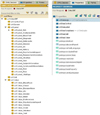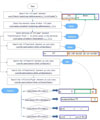Abstract
Objective
This study aims to develop the web-interface creator, which automatically changes the Case Report Form(CRF) web page when the protocol developer in any clinical study revises the ontology of CRF.
Methods
This study established the conceptual model of CRF on oriental and western medicine, and developed ontologies. A program was developed to produce online-based a input form through the parser that generates automatically HTML script from OWL.
Results
The CRF applied in this study is a draft through consensus of experts for stroke research at the Korea Institute of Oriental Medicine. The ontology of CRF consisted of Label, ControlType and Value classes and hasControl, hasValue and hasSymptoms properties. The Label is the class of question items groups, so it could have CRF questionnaire instances. The ControlType is the class that expresses controls such as checkbox, text, etc in the HTML script. The Value class represents selections for each items. Finally, the HTML script was created by XSL transformation from the OWL script.
Figures and Tables
References
2. Kim HG, Kim MK. Ontology Technology in Medical Informatics. Journal of Korean Society of Medical Informatics. 2003. 9(3):213–219.

3. Zhou X, Wu Z, Yin A, Wu L, Fan W, Zhang R. Ontology Development for Unified Traditional Chinese Medical Language System. Artif Intell Med. 2004. 32(1):15–27.

4. Knowledge of oriental medicine web service. Accessed November 25, 2006. Available at:
http://jisik.kiom.re.kr.
5. Ko YM, Eom DM. The study on the design of korean medical article retrieval system supporting semantic navigation based on ontology. Korean Journal of OrientalMedicine. 2005. 11(2):35–52.
6. Park JH, Shin SW, Jung GS, Park KM, Kim SH. Development and evaluation of ontology for diagnosis in oriental medicine. Korean Journal of Oriental Physiology and Pathology. 2006. 20(1):202–208.
7. Lee HS, Lee TY. A study of the design of ontoology-based prescription knowledge management system of oriental medicine. Journal of theKorean Society for Information Management. 2003. 20(1):341–371.
8. Lim HS, Park KM. Interface design for structured data entry in computerized patient records system and its development. The Journal of the Korea Institute of OrientalMedical Diagnostics. 2003. 7(1):76–82.
9. ISO/TC 215WG3 N231 - Draft ISO/DTS 22789 (ballot version.7) Health informatics - Conceptual framework for patient findings and problems in terminologies.
10. ISO 17115 Health informatics - Vocabulary for terminological systems. 2005.




 PDF
PDF ePub
ePub Citation
Citation Print
Print
















 XML Download
XML Download